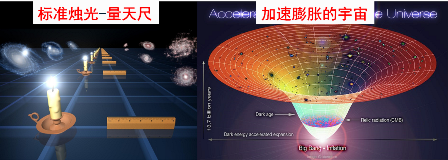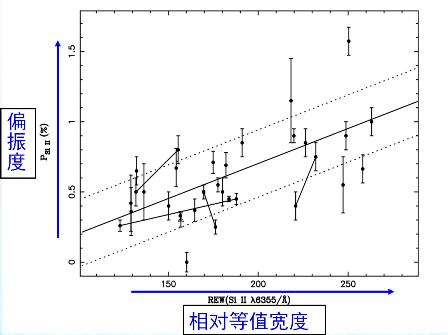Last month, the The Astrophysical Journal published a paper by MENG Xiangcun, ZHANG Jujia & HAN Zhanwen in Yunnan Observatories (YNAO), Chinese Academy of Science. The paper entitled A Polarization Sequence for Type Ia Supernovae? reveals that all type Ia supernovae (SNe Ia) obey a universal polarization sequence.
SNe Ia characterize themselves as strong silicon absorption lines in their spectrum, but without hydrogen and helium line.After correction by their light curve, SNe Ia may be taken as standard candle to measure distance, which leads to the discovery of an accelerating Universe. The discovery means that there is a kind of mysterious dark energy in our Universe and our Universe is dominated by the dark energy.
Although SNe Ia is very important in cosmology, so many problems on SNe Ia are still unclear, e.g. the progenitor problem and explosion mechanism, which could hamper their use for precision cosmology. Different progenitor models and different explosion models predict different geometry of the supernova ejecta, which may result in the polarization and different shape of absorption lines. Therefore, analysis on the polarization and spectrum together may give constraint on the nature of SNe Ia.
Combined the polarization data in literatures with the observational data from YNAO 2.4 telescope, researchers found that all SNe Ia follow a universal polarization sequence. This would be a strict constraint on the explosion and progenitor models of SNe Ia. This sequence could mean that the explosion mechanism is the same for all SNe Ia, whatever their progenitors are. At present, no simulation clearly shows such a sequence in literatures. Whatever, the so-called delayed detonation model may qualitatively explain the sequence.

Fig. 1: Schematic diagram for standard candle and accelerating Universe. Image by MENG Xiangcun

Fig. 2: Correlation between the polarization and relative equivalent width (REW) of the Si II 635.5 nm line. Solid line shows the linear fit and dotted lines correspond to a vertical deviation of 1σstatistical error. Image by MENG Xiangcun
Contact:
MENG xiangcun
Yunnan Observatories, Kunming, China
E-mail: xiangcunmeng@ynao.ac.cn
Tel: 0871-63920136